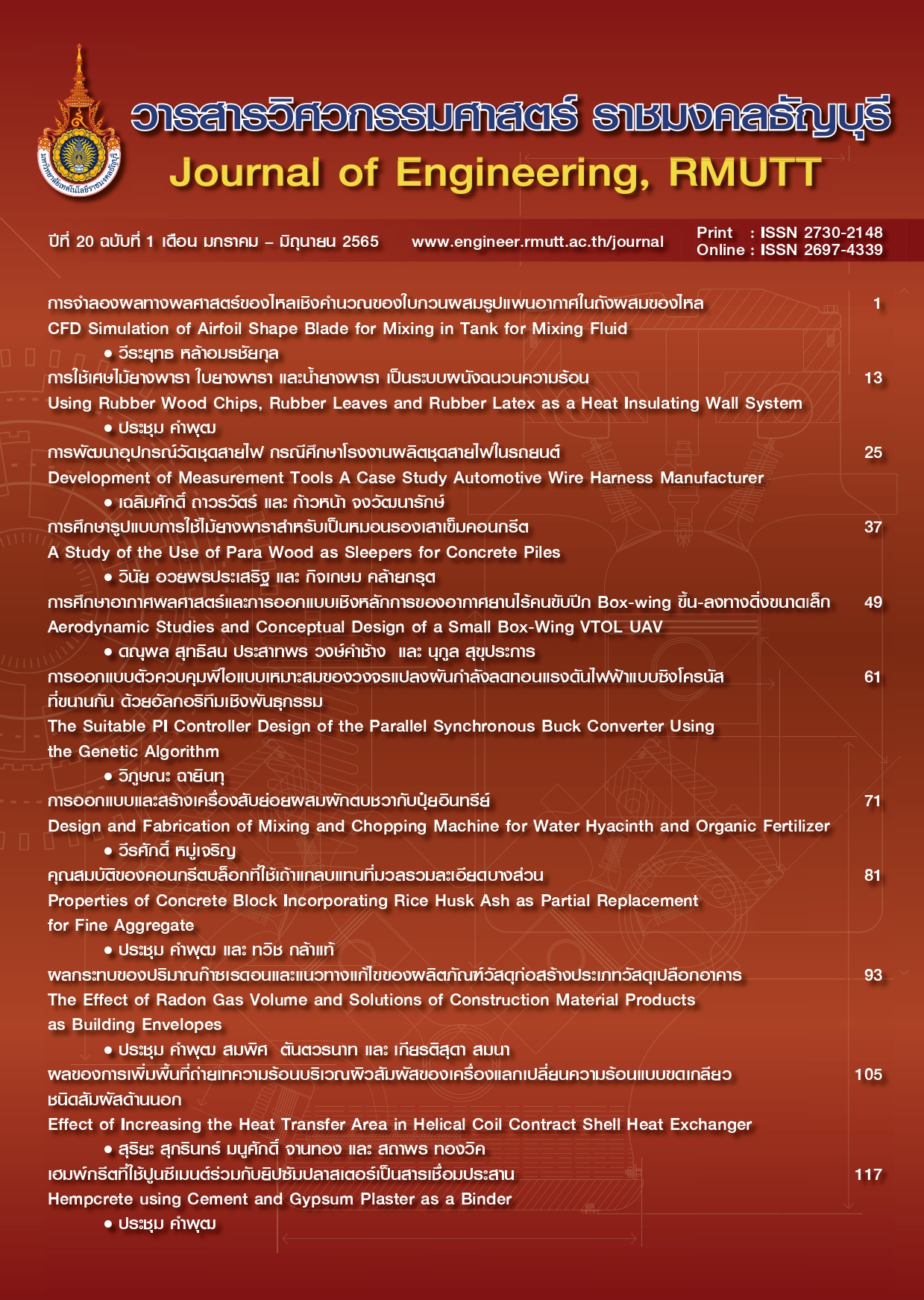Effect of Increasing the Heat Transfer Area in Helical Coil Contract Shell Heat Exchanger
Main Article Content
Abstract
This paper presents the thermal analysis in the helical coil of coil-contract-shell type heat exchanger (CCS).This in use helical coil is applied through increasing the lateral contact surface area by rolling. This process causes a pipe with a round cross-section (OC) to be converted to a pipe that is flat. (FC) and make it hydraulic diameter increase. Three FC samples were tested using water at 50 ◦C as the working medium and the flow rate was controlled between 0.2-2.5 l/min under constant tube surface temperature conditions. The FC with the highest hydraulic diameter had an average 21% reduction in total heat transfer and reduced convection capacity compared to the FC sample with the lowest hydraulic diameter, with flow rate is an auxiliary factor. This test showed an average increase in heat energy transfer over the flanks. 37% in the example FC with the maximum hydraulic diameter. This result is beneficial for the CCS heat exchanger because it transfers the heat energy on the side in contact with the conductor storage tank. Compared to FC with similar OC hydraulic dimmer has a high total heat transfer, but most of the heat is transferred to the insulated side.
Article Details

This work is licensed under a Creative Commons Attribution-NonCommercial-NoDerivatives 4.0 International License.
The manuscript, information, content, picture and so forth which were published on Frontiers in engineering innovation research has been a copyright of this journal only. There is not allow anyone or any organize to duplicate all content or some document for unethical publication.
References
Yang L, Yuan H, Peng J-W, Zhang C-L. Performance modeling of air cycle heat pump water heater in cold climate. Renewable Energy. 2016;87:1067-75.
Ramaraj S, Braun JE, Groll EA, Horton WT. Performance analysis of liquid flooded compression with regeneration for cold climate heat pumps. International Journal of Refrigeration. 2016;68:50-8.
Nouri G, Noorollahi Y, Yousefi H. Solar assisted ground source heat pump systems – A review. Applied Thermal Engineering. 2019;163.
Yang Z, Qu M, Gluesenkamp KR. Ammonia-based chemisorption heat pumps for cold-climate heating applications: A comprehensive review. Applied Thermal Engineering. 2020;179.
Arpagaus C, Bless F, Schiffmann J, Bertsch SS. Multi-temperature heat pumps: A literature review. International Journal of Refrigeration. 2016;69:437-65.
Gao P, Chang M-M, Zhang C-L, Shao L-L. System principles and applications of hybrid sorption–compression heat pump – A review. International Journal of Refrigeration. 2019;108:14-25.
Lazzarin R. Heat pumps and solar energy: A review with some insights in the future. International Journal of Refrigeration. 2020;116 :146-60.
Bellos E, Tzivanidis C, Moschos K, Antonopoulos KA. Energetic and financial evaluation of solar assisted heat pump space heating systems. Energy Conversion and Management. 2016;120:306-19.
Kong R, Deethayat T, Asanakham A, Kiatsiriroat T. Performance and economic evaluation of a photovoltaic/thermal (PV/T)-cascade heat pump for combined cooling, heat and power in tropical climate area. Journal of Energy Storage. 2020;30.
Yang H, Cui P, Fang Z. Vertical-borehole ground-coupled heat pumps: A review of models and systems. Applied Energy. 2010; 87(1):16-27.
Ortega I, Sieres J, Cerdeira F, Álvarez E, Rodríguez J. Performance analysis of a R407C liquid-to-water heat pump: Effect of a liquid–vapor heat exchanger and domestic hot water production. International Journal of Refrigeration. 2019;101:125-35.
Chingulpitak S, Wongwises S. A comparison of flow characteristics of refrigerants flowing through adiabatic straight and helical capillary tubes. International Communications in Heat and Mass Transfer. 2011;38(3):398-404.
Blanco DL, Nagano K, Morimoto M. Experimental study on a monovalent inverter-driven water-to-water heat pump with a desuperheater for low energy houses. Applied Thermal Engineering. 2013;50(1):826-36.
Jamshidi N, Farhadi M, Ganji DD, Sedighi K. Experimental analysis of heat transfer enhancement in shell and helical tube heat exchangers. Applied Thermal Engineering. 2013;51(1-2):644-52.
Ghorbani N, Taherian H, Gorji M, Mirgolbabaei H. An experimental study of thermal performance of shell-and-coil heat exchangers. International Communications in Heat and Mass Transfer. 2010;37(7):775-81.
Askar E, Schröder V, Schmid T, Schwarze M. Explosion characteristics of mildly flammable refrigerants ignited with high-energy ignition sources in closed systems. International Journal of Refrigeration. 2018;90:249-56.
Colbourne D, Suen KO. Comparative evaluation of risk of a split air conditioner and refrigerator using hydrocarbon refrigerants. International Journal of Refrigeration. 2015;59:295-303.
Yunus AC. Heat and mass transfer: fundamentals and applications: McGraw-Hill Education; 2019.
Hussein AM, Dawood HK, Bakara RA, Kadirgamaa K. Numerical study on turbulent forced convective heat transfer using nanofluids TiO 2 in an automotive cooling system. Case Studies in Thermal Engineering. 2017;9:72-8.
Pavan Kumar E, Kumar Solanki A, Mohan Jagadeesh Kumar M. Numerical investigation of heat transfer and pressure drop characteristics in the micro-fin helically coiled tubes. Applied Thermal Engineering. 2021;182.
Schmidt EFJCIT. Wärmeübergang und druckverlust in rohrschlangen. 1967;39(13) :781-9.
Hardik BK, Baburajan PK, Prabhu SV. Local heat transfer coefficient in helical coils with single phase flow. International Journal of Heat and Mass Transfer. 2015;89:522-38.
Kong R, Deethayat T, Asanakham A, Kiatsiriroat T. Heat transfer phenomena on waste heat recovery of combustion stack gas with deionized water in helical coiled heat exchanger. Case Studies in Thermal Engineering. 2018;12:213-22.
Abdolbaqi MK, Azmi WH, Mamat R, Mohamed NMZN, Najafi G. Experimental investigation of turbulent heat transfer by counter and co-swirling flow in a flat tube fitted with twin twisted tapes. International Communications in Heat and Mass Transfer. 2016;75:295-302.


